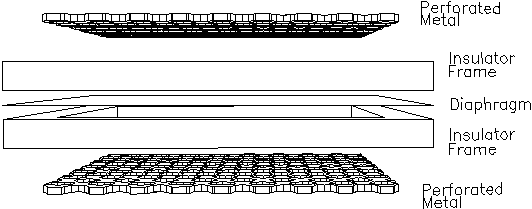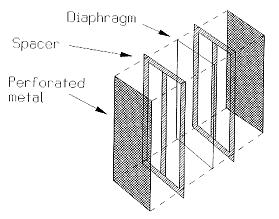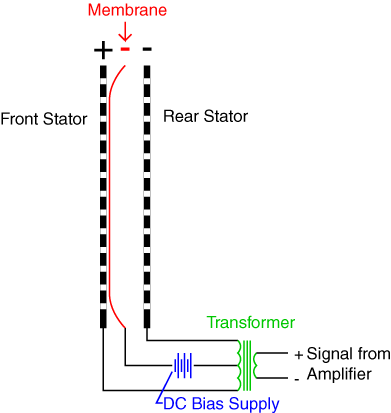This is a hopefully relatively unbiased view of the differences between a Magnetic Planar and an Electrostatic. This came about from what I discovered about the two when I was deciding whether to get one versus the other. This is a rough draft, so send me any corrections or additions you want to see. The intent is to compare and contrast the strengths and weaknesses of these two speakers.An electrostatic is basically a large parallel plate capacitor. Take a large thin foil plate capable of some excursion, charge it up with a bunch of electrons (the same thing that happens with static cling). Parallelly mount a fixed metal screen in front of it that you connect to an amplifier. The statically charged plate will be attracted to and repulsed from the fixed screen as the amp’s signal oscillates from opposing to like charge, respectively. Hence, the static plate vibrates back and forth with the musical signal & pushes acoustic soundwaves through the screen.
 
|
Now, just add another metal screen on the other side of the foil plate, and attach it to the other terminal of a push-pull amplifier’s channel. Thus, as one screen attracts the foil because the signal is momentarily of opposed charge, the other screen is repelling because it’s signal is inverted (equal & opposite) and the new screen is of like charge. This screen-foil-screen configuration also makes sure the field between the screen is uniform electrical potential gradient necessary for linear conversion of electrical energy to acoustic.

At this point it should have occurred to you that these forces are proportional to the charges. Thus, it is common to install a set-up transformer on the AC signal that is later converted to low-current high-voltage DC to maintain the foil’s fixed static charge. It is also common for the designer to incorporate a step-up signal transformer that also increases efficiency. This transformer originally had a balanced output because some owners had single-ended amplifiers, but whose center tap is used in modern designs as a common mode rejection of ripple remaining on the rectified AC.
Electrostatics can have lightning-fast transient response (=D) and produce a very light and airy sound. However, this doesn’t come for free. The cost is usually much higher because of all the associated electronics. Plus, an input step-up transformer is a pretty serious component to put in your signal path, as they generally have poorer performance at the high and low frequency extremes, and hysteretic distortion of the entire midband. One advantage however is that because it’s coming after your power amp there is no DC component saturating the transformer, so it can operate with much better performance than a DC coupled transformer.
Electrostatics are obviously highly capacitive, which most solid state amps with their low damping factor and large amounts of negative feedback can’t handle. Solid state amps will tend to heavily oscillate driving a static. Tubes do very well however, especially OTL tube amps. Often tens of ohms in the low band which OTL’s like. Unfortunately they often drop to an ohm or so in the high band which most OTL’s can’t drive very well, so you can get high frequency roll-off or worse. A solution to this is usually found in adjusting, upgrading, or yanking the ESL’s input set-up transformer. This will increase the impedance that your OTL tube amp sees.
Also, ESLs can be prone to arcing over, and if you live in a very humid climate this can get worse. This was however, more of a problem for earlier generations then now. Also they are not very tweakable because of the complicated, very high voltage electronics involved. It’s difficult to get a good bass, unless you have very large panels, which are very hard to drive and expensive. For “reasonably” priced ‘statics, a common solution is to use a cone driver for the bass and the electrostatic panel for the mid on up. The problem then becomes seamlessly integrating the two. No cone drive can match the speed of the panel, so you have to judge if the performance is acceptable. The advantage of a hybrid design is good slam in the lower frequencies coupled with uncanny midband performance.
To my ears ‘statics can sound a little “fragile”, and are generally not as clear in the high and low bands (unless you spend really big bucks), but you can get a truly magnificent, possibly the most transparent sound on those higher end models. In theory they can be more transparent then your “equivalent” magnetic planar, because you can have a much lighter vibrating plate then you can in a magnetic planar. Like magnetics they require (especially on the bigger models) more power (sorry SET lovers!) and also like magnetics do magnificently with OTL’s such as the Atma-Sphere amp.
Magnetic planar’s and electrostatic planars are really two aspects of the same beast; I suggest hearing both if you are a planar type of person.
Resources for ‘statics